Balancing Whole Novels and Choice Reading
A MiddleWeb Blog
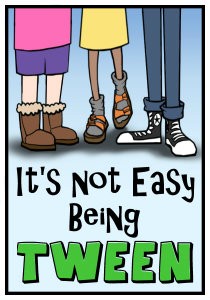
I consider each of these new ideas an ingredient that, once combined with my own seasoning, makes the special sauce that defines my classroom instruction.
Through my reading and in conference sessions, I’ve found that one curricular tradition that has taken a huge beating in the last several years is the teaching of the whole-class novel. It almost feels as if a gauntlet has been thrown down, and English teachers are forced to take sides: continue to teach whole-class novels or adopt the student choice model entirely.
I don’t believe it has to be either-or. Personally, I find that a combination of whole-class novels, free voluntary reading, and read-alouds produces the trifecta of a winning reading curriculum.
Defining the problem(s)
What I believe most people dislike about the whole-class novel approach is that (1) it continues to be the main source of reading instruction in secondary schools; and (2) for the most part, the novels are being taught badly. If these two issues are addressed, whole-class novels can have a valuable place in a middle school English class.
First things first: I like teaching whole-class novels. There, I’ve said it. Over the years, I have found the whole-class novel to be an incredible community building and learning process for my students, and I have come up with some ways that I believe make it a worthwhile experience.
You don’t have to commit Readicide when you teach a novel, so that all you’re left with is a beaten-down carcass of what was once a perfectly fine work of literature. Students will engage with a text if given the opportunity, guidance, and support they need.
I’m in good company
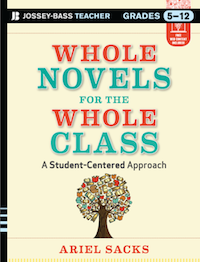
I have been teaching similarly to Sacks for several years (ever since I read Readicide and The Book Whisperer long ago) and I am happy to see her book become so successful because it means that there are like-minded teachers out there. (I also know that many of those who rally against whole-class novels still incorporate the reading aloud of entire novels – in effect sharing a group reading experience with their students.)
The way I used to teach
The first step in achieving a balance of whole-novel teaching and student choice is to quit over-teaching books and killing the love of reading. Like many secondary English teachers, I began my career by teaching novels in the same way I was taught. I assigned a chapter or two at a time with vocabulary words to define, chapter questions to answer, useless worksheets, mundane projects that I believed would add some fun, and a summative comprehension test. The problem: I hated every minute of teaching that way and the kids were bored to tears.
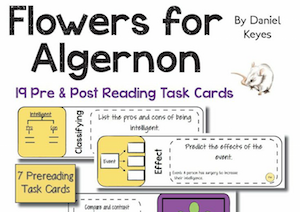
I do remember somewhat enjoying the teacher guiding us toward his or her interpretation of the work and the rare opportunities for class discussion.
Discovering a novel together
Later, in my classroom, I wanted to capitalize on student discussion and discovery. I was already moving toward eliminating rote work when the right book appeared at the right time. Thank goodness for Kelly Gallagher’s Readicide for giving me research-based permission to do what I’d always felt was right for students.
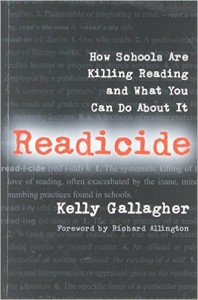
Like Goldilocks, I am searching for what feels “just right.” I am constantly refining my methods and have come up with some techniques that are working for me. Not only do my students enjoying reading a novel together in class, they also are able to meet and exceed the required standards.
Inclusive learning
Because of my background as a special education teacher, I often joke that I teach all of my students as if they are gifted students with learning differences. I say this in jest, but I truly do use the same techniques that I used to meet the needs of students on both ends of the continuum. I scaffold the learning so that each student can be successful while providing innovative, high-interest activities to satisfy their innate curiosity and drive.
Below are some of the supplemental activities, in addition to discussing the novel, that I used when I taught an 8th grade science fiction unit revolving around Lois Lowry’s The Giver. It is important to note that I never spend more than three or four weeks on a novel. I have a short attention span.
The Giver: Reading the Whole Book
Prior to reading:
As a class, we discussed the idea of Utopian societies and how they have been attempted over the course of history.
- Students worked in groups to develop their own Utopian society including such items as a flag with a representative symbol, a constitution of their beliefs, an advertisement of their unique assets, and a set of rules to be followed.
During reading:
- We practiced storytelling using a favorite family memory.
- We determined current milestone birthdays and their societal meaning.
During and after reading:
We read additional science fiction such as Vonnegut’s Harrison Bergeron, and we watched a couple of Twilight Zone episodes (“Number 12 Looks Just Like You” and “Eye of the Beholder”). We listened to the songs “One Tin Soldier,” “Utopia,” and “Imagine.” We discussed the hippie movement and its goals. We compared and contrasted these in discussions of the ideas of total equality and the definition of perfection.
- We debated whether it would be good or bad to have our negative memories removed.
- We made connections to global, modern society today.
Help from touchstone texts
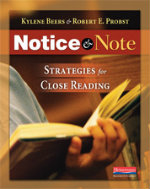
This book, along with Readicide, Book Love, and The Book Whisperer, are my touchstone texts that each came along at the right time and gave me the exact tools I needed.
In my next article on whole novels, I will share how I scaffold our whole-class novel experiences from the beginning to the end of the year to achieve a gradual release of responsibility.
Meanwhile: Are you teaching whole novels? And if so, what are some of your strategies?

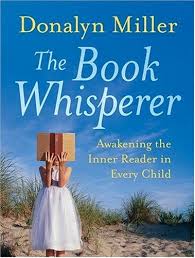
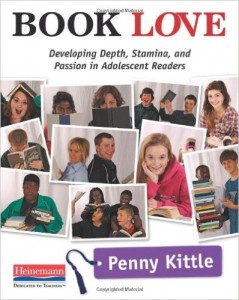
































Hi I teach year 6 in a nswschool in Australia. Teaching whole class novels in this way is my key tool. You are right about that sweet spot. It is different for each class. I like doing the hot seat during a reading where we stop and a few students take on the role of a character and the other students question them about motives etc. Truly insightful.
Great idea! Adding that one to the toolbox. Thanks.
I too use whole novels in my instruction—and I teach honors-level sophomores! You are right: finding the right “in-between” for the novel is so crucial.
Out of curiosity, about how many novels do you incorporate into your curriculum each year?
I teach under trimesters, so I am required to cover 1 per trimester.
I am a middle school special ed teacher of students with moderate/severe disabilities, that never dreamed she would read novels with her students. . What convince me to change my mind? A reading consultant made us realize we didn’t have to read the book word-for-word, but to use the novels, and adapted versions with pictures and summaries to get the gist of the chapter and story. She encouraged us to Read a novel as a “standards based units of study”, similar to old style thematic units. I was amazed at how much my students enjoyed the project. Several students would ask “are we going to read the book today?” Music to my ears. I had never heard them ask that before. They normally dreaded having to read. We completed assignments based on alternate assessment core content standards for all subject areas. Ex: The Holes novel we completed several assignments about the hole the boys had to dig using volume formula- math, desert environment – science, etc. and finally compared/contrasted the book with movie version using graphic organizers. The students could write their answers or cut/paste picture answer choices based on their ability level. Now as this article stated, our general education classes seemed to have stopped reading novels because state testing is based on passages, but I found it really did help my students learn the joy of ‘reading’ a book even if they could not read the words themselves. Now there are so many screen readers they can use and even amazon.com has audible books which have sounds affects in addition to the book being read aloud. The Sherlock center has hundreds of books that have already been adapted with pictures. http://www.ric.edu/sherlockcenter/wwslist.html. We are planning on reading Hatchet next. I’m looking for materials on ‘Cheaper by the Dozen and The One and only Ivan. I’m still new to this process, so any ideas or suggestions to find materials or lesson plans that I could adapt would be appreciated.
That’s fantastic! I am a former special education teacher, and I did many of the things you listed (and I still use them all today). I am also a huge fan of audio books. Keep up the great work.
Thank you so much for your article. I have just been told I should no longer teach a class novel, even one. Choice is wonderful, but it makes me sad that my students will be deprived of the community and rich learning that come with reading one together. One of my favorite books is Jeffrey Wilhelm’s Action Strategies for Deepening Comprehension. Since so many kids are kinesthetic learners, we should get them embodying meaning like this. I hope you live it as much as I do.
Thank you for this article! Great info as I’m a new teacher and eager to do a novel study with my 5th grade class.
Curious….Do you do only offer one book for the whole class at a time or do you offer choice and group students to meet them within their reading level? Any feedback based on your experience is greatly appreciated:)